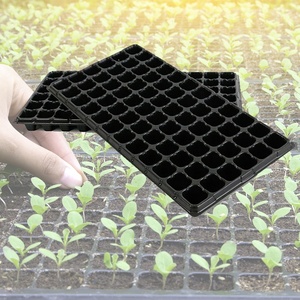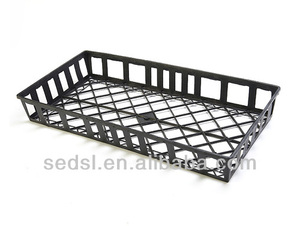(6280 products available)
































































































































































































































Black plastic nursery trays are often used to start seeds and transplant young plants. They are designed for different gardening needs. Here are some common types to consider:
Cell count:
Black plastic seed trays come in different cell counts. The cell count is the number of holes or compartments in each tray. People who start many plants at once may choose a tray with a higher cell count, like 72 or 128 cells. These trays are great for small seeds that require more seeding. However, for larger plants or less intensive planting, lower cell count trays with 24 or 36 cells are better. They give each plant more space to grow without crowding.
Tray depth:
The depth of the trays matters for the plants’ roots. Shallow trays, about an inch deep, are suitable for starting seeds with small root systems. Medium trays around two inches deep work for many seedlings. However, deeper trays that are three inches or more are needed for plants that grow big transplants or have long roots. Sufficient depth prevents roots from becoming cramped and stunted.
Tray material and durability:
Black nursery trays are made from durable plastic. The material is tough so that people can use the trays repeatedly without damage. This durability is cost-effective for commercial growers and hobby gardeners. There are also biodegradable tray options made from plant materials. These trays break down naturally over time. They are better for the environment but are less long-lasting. The grower's priorities will determine which material works best.
Drainage holes:
Good drainage is vital for healthy plants. Black plastic nursery trays with holes in the bottom allow excess water to escape. This drainage hole design prevents overwatering, which can harm plants. Some trays have slotted or mesh bottoms for even better drainage and airflow to the roots. Trays with no holes are unsuitable for seedlings since water will pool and drown the plants. Growers should always choose trays with proper drainage holes for thriving plants.
Tray shape and stacking:
The shape of the nursery trays affects their use. Flat, rectangular trays fit neatly on shelves or benches in greenhouses. They make efficient use of space. Some growers prefer square or round trays for specific planting needs. Trays should stack easily when not in use. Stacking saves room and keeps the trays clean until needed. The grower can select the best shape and stacking features for their greenhouse or garden layout.
Black plastic nursery trays are designed for one key purpose: to support young plants in the early stages of their life. Their design features include:
In summary, plastic nursery trays are well-made to support young plants. Their durability, cell design, and drainage features make them essential for gardeners.
Black plastic nursery trays are very important in different industries. These trays make it easy to handle and transport things like seedlings and products. In the horticulture industry, black nursery trays reliably grow and move seedlings, plants, and small trees. They ensure that each plant gets enough space, air, and water to grow well. The trays are strong and light, making them easy to move around a greenhouse or garden.
Moreover, these trays fit well on shelves and carts, optimizing space for large-scale plant production. When it comes to the product assembly and distribution industry, black plastic trays serve as a convenient and organized solution for holding and transporting goods. The sturdy build of the trays protects the items within them during handling and shipping. Additionally, the uniform size and shape of the trays make them easy to stack and store, maximizing space efficiency in warehouses and distribution centers.
Furthermore, black nursery trays are widely used in the automotive industry for parts containment and assembly line usage. The trays are designed to hold small, loose, or irregularly shaped parts, such as screws, bolts, and washers. Using these trays ensures that the parts are easily accessible and organized, preventing delays in the assembly process. Additionally, the robust construction of the trays can withstand the rigors of the assembly line, making them a durable choice for the automotive industry.
In the medical industry, black nursery trays hold and transport medical supplies and equipment. The trays provide a clean and sterile environment for holding critical medical items. Also, the durable design of the trays ensures that they can handle the weight of heavy medical equipment. Furthermore, the easy-to-clean surface of the trays makes them suitable for use in a sterile environment. Black plastic trays are essential in many scenarios. They show how versatile and useful these trays are across different industries and applications.
From a functional point of view, there are several factors to consider when choosing black plastic nursery trays, such as:
Durability:
Durability is an important factor to consider when choosing black plastic nursery trays. These trays are normally made from ABS (acrylonitrile butadiene styrene) and APET (amorphous polyethylene terephthalate), which are both tough, impact-resistant plastics. This makes the trays able to withstand the rigors of handling, transportation, and storage without easily breaking or cracking. Users should also ensure they select trays that are not too flimsy but have the right thickness for long-term use. The durability of the trays will allow for repeated use, reducing costs in the long run and being more environmentally friendly by decreasing plastic waste.
Cost considerations:
When choosing black plastic nursery trays, users should consider the total cost, which includes the purchase price and any additional costs associated with their use. For instance, thinner trays may be cheaper upfront but could incur extra costs due to breakage during handling or the need to replace them more frequently. It's worthwhile to invest in more durable trays that may have a higher initial cost but will pay off over time through increased longevity and reduced risk of plant damage.
Environmental impact:
In recent years, there has been a growing emphasis on sustainability within the plastic tray manufacturing industry. This has led to the creation of nursery trays that are greener, such as those made from recycled materials or ones that can be recycled and reused. Suppliers are also offering biodegradable trays that can break down in composting facilities as an alternative to landfilling. Users should look for nursery trays that have eco-friendly features, which not only help to protect the environment but also align with their business's corporate social responsibility goals.
Q1. Can black plastic nursery trays be recycled?
A1. Yes, black plastic nursery trays can be recycled. However, they must be taken to a facility that accepts this type of plastic. Many municipalities do not accept black plastic for curbside recycling, so it is important to check local guidelines. Some companies also offer take-back programs for recycling black plastic trays.
Q2. What are the benefits of using black plastic nursery trays?
A2. Black plastic nursery trays have several advantages. They are durable and can withstand the weight of wet soil and plants. The smooth surface makes them easy to clean and reuse. Black color also helps hide dirt and stains, keeping the greenhouse looking professional. Additionally, these trays provide a consistent environment for plant growth, leading to uniform and healthy seedlings.
Q3. How should black plastic nursery trays be stored?
A3. Black plastic nursery trays should be kept in a cool, dry place away from direct sunlight. Stacking them neatly will prevent warping or damage. If storing for long periods, cover the trays to protect them from dust and debris.
Q4. Can biodegradable alternatives to black plastic nursery trays be used?
A4. Yes, there are biodegradable alternatives to black plastic nursery trays. These trays are made from plant-based materials and will break down in a composting facility. Biodegradable trays are a good choice for nurseries that want to reduce their plastic use and environmental impact.
Q5. What should be done with black plastic nursery trays after use?
A5. Black plastic nursery trays should be cleaned and reused whenever possible to reduce waste. If they can no longer be used, take them to a recycling center that accepts black plastic. Do not throw them in the regular trash, as they will not decompose in a landfill.